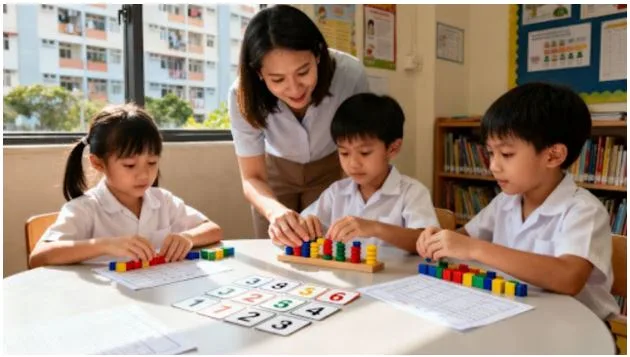Primary 1 Mathematics Education in Singapore Sees Growing Demand for Specialised Support
Something’s shifted in how Singaporean families approach their children’s first year of formal schooling. Walk past any tuition centre on a weekday afternoon and you’ll spot something interesting: six and seven year olds, fresh from Primary 1 classes, settling in for additional mathematics lessons.
This wasn’t the norm even five years ago. Back then, tuition typically started around Primary 3 or 4, when content became noticeably harder. Now? Parents are intervening much earlier, recognising that mathematical foundations laid in Primary 1 ripple outward through their child’s entire academic journey.
Those First Steps Matter More Than We Thought
Talk to any secondary school mathematics teacher and they’ll tell you the same thing. Students who struggled with basic number concepts in Primary 1 but never got proper help? They’re still struggling in Secondary 3. The gaps compound rather than disappear.
“I can spot which students had shaky Primary 1 foundations just by watching how they approach problems,” says Mrs Chen, who’s taught secondary mathematics for fifteen years. “They second guess themselves constantly. The anxiety around numbers is palpable.”
The Ministry of Education’s curriculum framework lays out progression thoughtfully enough. Start with concrete objects children can touch and manipulate. Move gradually toward pictures and diagrams. Finally introduce pure numbers and symbols. Sounds logical, works beautifully in theory.
Reality inside a classroom with 35 energetic six year olds? Significantly messier. Some children grasp number bonds instantly whilst others still can’t reliably count to twenty. Teachers do their best, but providing truly individualised attention becomes nearly impossible.
When Maths Anxiety Takes Root
Here’s something that surprises many parents: attitudes towards mathematics form incredibly early. By Primary 2, many children have already decided whether they’re “good at maths” or not. That self perception becomes remarkably sticky.
“We’re seeing parents wake up to this,” observes Mr Tan, who runs a learning centre in Tampines. “They used to wait until PSLE panic set in. Now they’re coming when their Primary 1 child starts saying things like ‘I hate maths’ or ‘I’m stupid at numbers.’ That early intervention makes enormous difference.”
The curriculum itself seems straightforward enough. Number bonds to 10. Addition and subtraction within 20. Basic measurement concepts. Simple shapes and patterns. Adults breeze through these concepts without thinking twice.
Six year olds process mathematical ideas completely differently. What seems obvious to us requires genuine cognitive leaps for them. And when they don’t make those leaps smoothly, confusion sets in fast.
Small Groups Make All The Difference
Researchers at places like the University of Chicago Education Lab have been studying this intensively. Their findings? Small group instruction produces dramatically better outcomes than large classroom teaching, especially for students needing extra support.
The reasons make intuitive sense once explained. In groups of three or four, teachers actually see how each child thinks. Where does confusion creep in? Which steps get skipped? What false assumptions are being made?
“Children feel safer asking questions too,” adds Miss Lim, a former MOE teacher now running private classes. “No audience of thirty classmates potentially judging them. That psychological safety matters tremendously at this age.”
Parents Walk A Tricky Tightrope
Supporting your Primary 1 child’s mathematical development requires delicate balance. Push too hard and you create the very anxiety you’re trying to prevent. Step back too far and they might miss crucial scaffolding they need.
Dr Priya Sharma, a child psychologist who consults with several schools, puts it bluntly: “Your attitude about mathematics rubs off on your child more powerfully than any textbook. Parents who say things like ‘I was always terrible at maths’ are essentially giving their children permission to fail.”
Better approach? Weave mathematics naturally into daily life. Count stairs whilst climbing. Compare prices at the supermarket. Identify shapes in buildings you pass. Suddenly maths isn’t this separate scary school subject. It’s just part of making sense of the world.
Professional Help Gets More Sophisticated
The tuition industry’s responded to growing demand for Primary 1 support by developing more age appropriate programmes. Gone are the days of simply drilling worksheets. Modern approaches use games, stories, and hands on materials that match how young children actually learn.
P1 Maths Tuition in Singapore represents this newer wave. Small classes. Teachers trained specifically for early childhood. Focus on building genuine understanding rather than just getting correct answers on worksheets.
“We’re not trying to push kids ahead of their peers,” explains one programme coordinator. “The goal is ensuring they really understand what addition means, what numbers represent, why certain strategies work. That solid foundation lets them build confidently later.”
Technology Helps, But Only So Much
Educational apps for young children proliferate wildly. Colourful characters, instant rewards, adaptive difficulty levels. Parents download them hoping for magical solutions.
Reality check from educators? These tools have limited value for six year olds learning fundamental concepts.
“Young children need to physically manipulate objects,” insists Mr Wong, a primary mathematics specialist. “Moving actual counters, grouping real objects, touching and rearranging concrete materials creates neural pathways that tapping a screen simply cannot replicate.”
Apps work fine for practice and reinforcement once concepts are grasped. But they’re supplements, not replacements for hands on learning with patient human guidance.
Ripple Effects Last Years
Money spent on Primary 1 mathematics support isn’t just about getting good marks on that year’s report card. Strong foundations established during this crucial year make every subsequent year easier.
Children who develop solid number sense carry that advantage forward. Students comfortable with mathematical thinking tackle Primary 4 fractions and decimals more confidently. Kids who learned to view problem solving as an interesting puzzle rather than a threatening ordeal approach secondary school algebra differently.
“I can always tell which students had strong early support,” remarks a junior college mathematics teacher. “They don’t just know more. They think about problems more flexibly. That mental habit was built years earlier.”
The inverse proves equally true. Children who struggled with basic concepts in Primary 1 without adequate support find each subsequent year progressively harder. New material constantly builds on incompletely understood foundations. Eventually, many just give up, convinced they lack some innate mathematical ability.
Assessment Starts Young Now
Primary 1 introduces children to formal testing, another significant shift from kindergarten’s more relaxed environment. How parents and teachers frame this matters enormously.
“We need to teach children that assessment shows what they’ve learned and what needs more practice,” suggests an educational consultant. “Not that it judges whether they’re smart or stupid. That reframing affects their entire relationship with learning.”
Regular informal checks help spot problems early. But this must be balanced carefully with maintaining enthusiasm and confidence. Nobody wants to create test anxiety in a six year old.
What Comes Next
Singapore’s education landscape keeps evolving. Awareness about early mathematical education’s importance will likely continue growing. Parents, teachers, policymakers increasingly recognise that investing in foundational years pays dividends throughout students’ academic careers and beyond.
The challenge? Making sure every child gets the support they need, regardless of whether their parents can afford extra tuition or recognise warning signs early.
“Mathematics ability isn’t innate talent that some children have and others don’t,” states Professor Lim from NIE. “Every child can succeed with appropriate support and encouragement. Our job as a society is ensuring that support reaches those who need it most, precisely when they need it.”
Back at that tuition centre, the Primary 1 students are wrapping up their session. They’re laughing, comparing their work, genuinely engaged. No tears, no anxiety, no “I can’t do this.”
Getting it right at this age matters. These children are building more than mathematical knowledge. They’re developing confidence, curiosity, and comfortable relationships with learning itself. That’s worth investing in.



